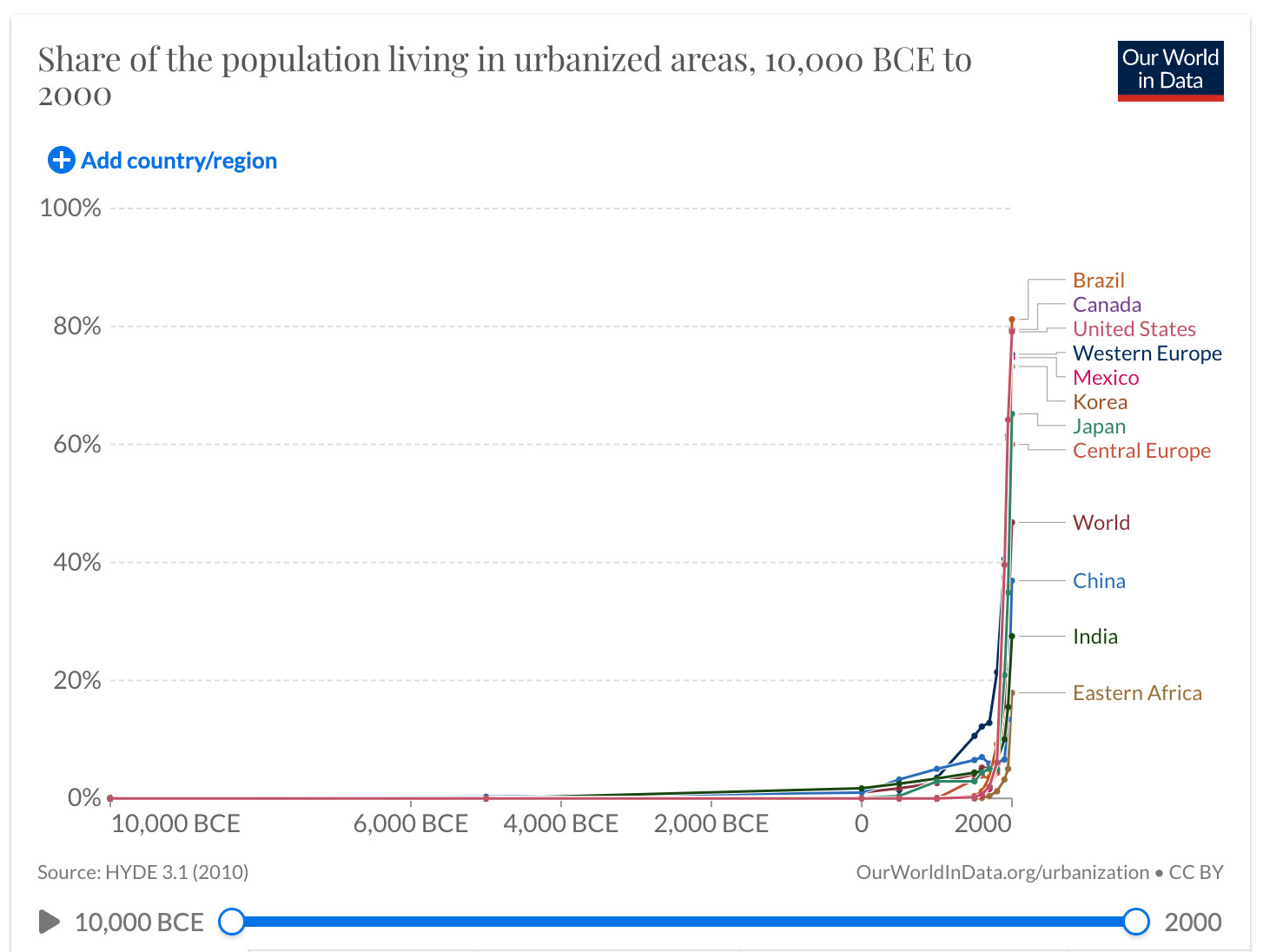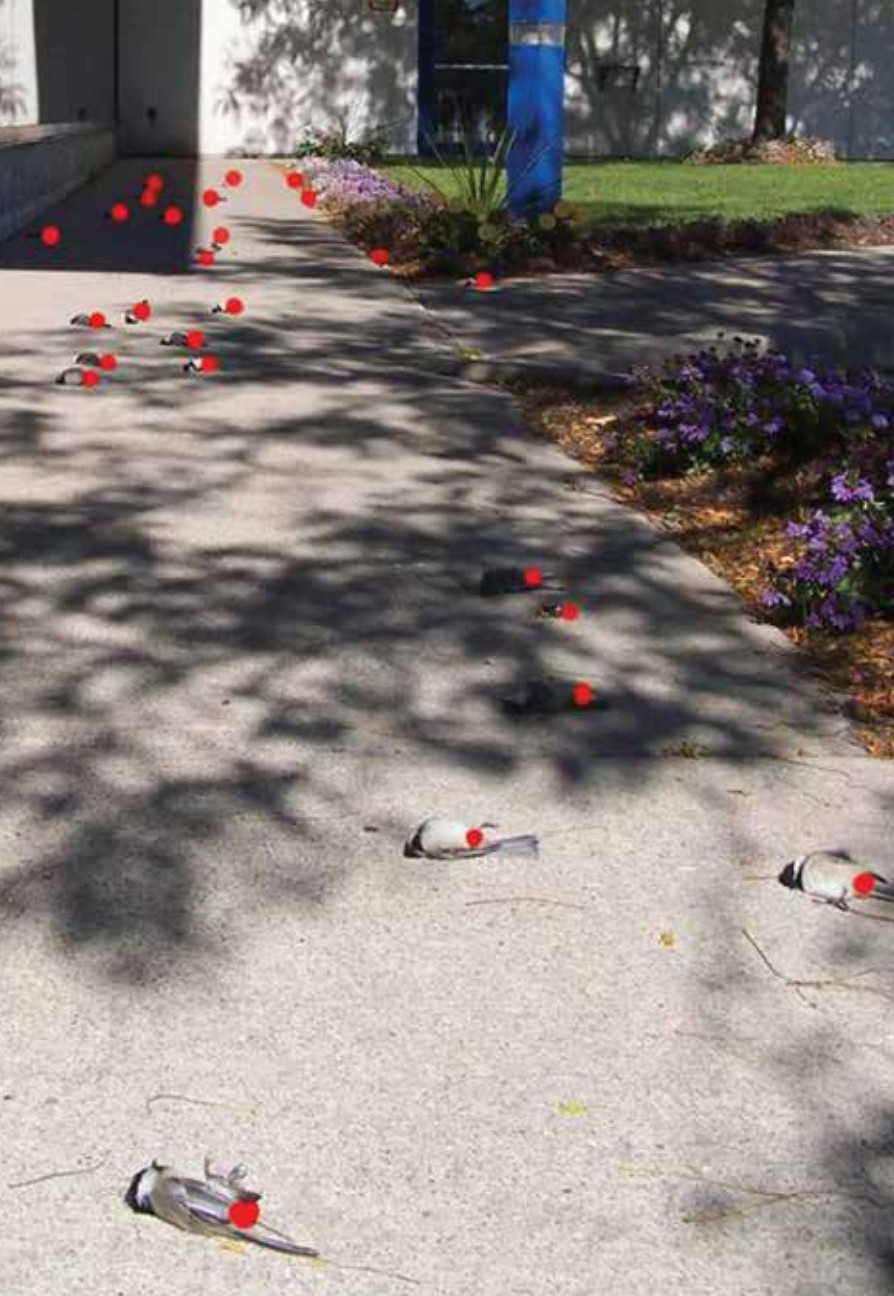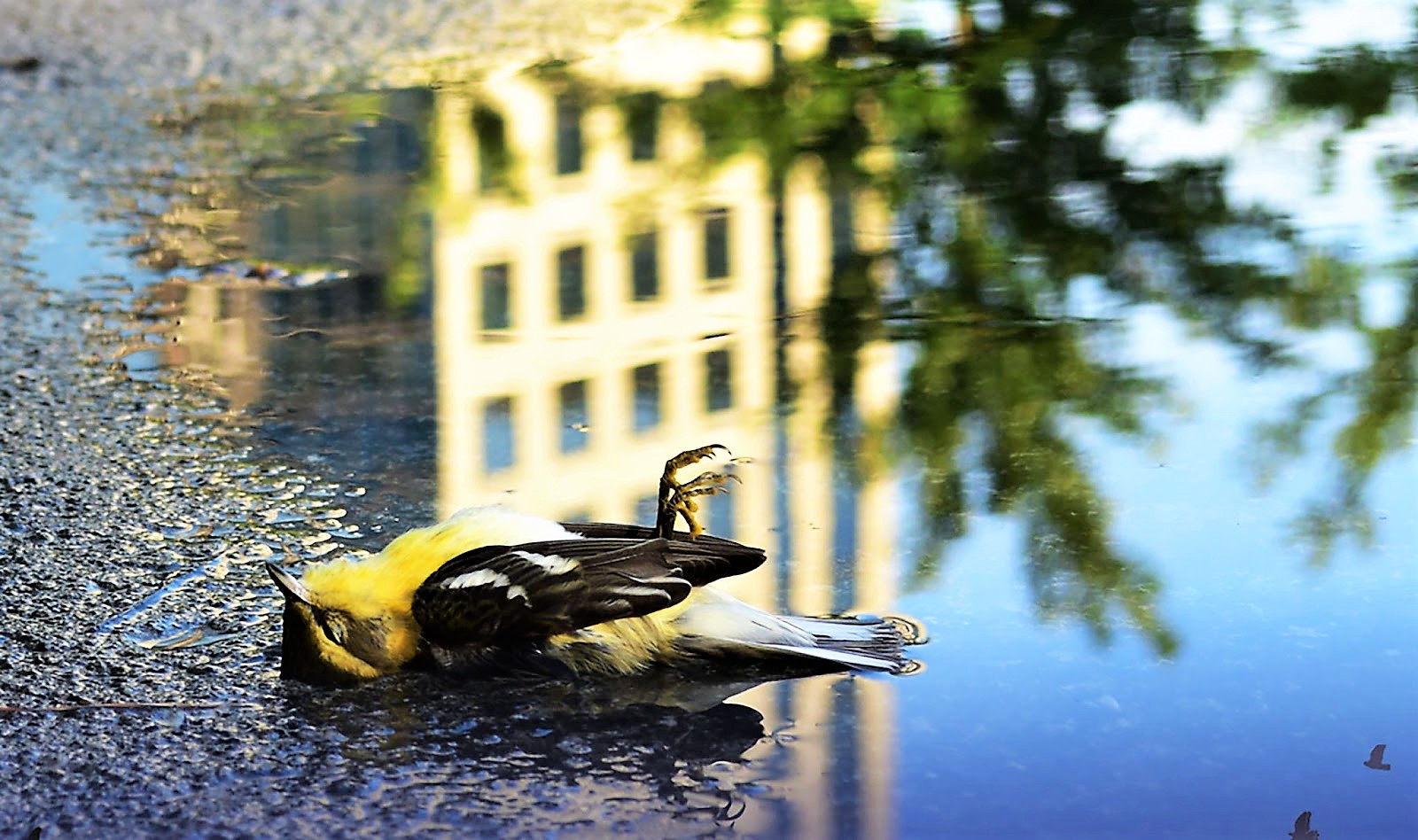
Millions of birds die needlessly in our cities every year, Bill 23 threatens to ratchet up the death toll
There is a constant cacophony of death in Canadian cities. Each year, millions of birds die in collisions with windows; feathered flight cut short as hollow bones snap like toothpicks against thick tempered glass. To hear this nation-wide flock of small bodies colliding with invisible walls would be akin to the staccato blast of a machine gun.
As the urban landscape expands, so too will the reflective windows experts and governments know full well are deadly to birds, without proper protections.
According to The World Bank, 56 percent of the world’s population currently live in urbanized areas, a proportion projected to skyrocket to approximately 70 percent by 2050. It continues a trend observed in many developed countries over the last 500 hundred years which has drastically altered the airspace avian species have been navigating for eons.

(Our World in Data)
City builders have the answer. It’s known as bird-friendly design. Residential home owners may have examples of this in their houses with stickers or decals on windows to deter birds from flying into them. There are much more sophisticated solutions for developers of large urban skyscrapers, but the addition of such design elements are not mandatory in Ontario, despite the evidence that bird species die without them. A study conducted in New York found that a 10 percent increase in the area of reflective and transparent glass on a building facade correlated with a 19 percent increase in the number of fatal collisions during the spring migration and a 32 percent increase in fall.

The black-capped chickadee death toll in a single morning outside a Toronto building in 2010. The developer of the building was prosecuted under the Ontario Environmental Protection Act for this design “death trap”.
(City of Toronto)
With Premier Doug Ford’s PC government trying to supercharge Ontario’s development, advocates and MPPs are rejuvenating calls to insert bird friendly design standards into the Ontario Building Code, which would force developers to implement these life-saving measures into new builds. However, as the fight and confusion surrounding the PC’s developer-friendly Bill 23 has shown, there isn’t much willingness from the current government to take the step.
For birds, Toronto is the murder capital of Ontario.
Because of the city’s proximity to Lake Ontario, where two major migration “flyways” swirl together, the dense congregation of skyscrapers with trendy glass facades—a norm of modern urban architecture—is a deadly obstacle in the middle of a bird highway. The City of Toronto contains one-third of all tall buildings in Canada.
The lesson that human and wildlife do not see the urban world the same way has been repeatedly learned the hard way—for both species. From the tragic scale of animals flattened to red smears on provincial highways sparking the creation of various wildlife corridors to carry them safely over or under the roadway, to the craftiness of racoons raiding Toronto garbage and green bins facilitating the need to devise a “raccoon-proof” lid. Toronto, and many other cities learned long ago that the acrobatic dips and sways of bird flight do not mix well with massive walls of thick glass.
It’s not a matter of poor eyesight. The optical evolution of many birds has far surpassed the human eye. Generally, birds have superb vision, but some species take things a fascinating step further. The Wilson’s snipe for example, can see a full 360 degrees around and 180 degrees above at the same time, like it has a pair of 360-degree cameras inserted into its small skull. The human eye is only able to focus on a single point of detail at one time. Eagles can hone in on four points at once, two from each eye.
Birds actually process information much quicker than many species, making them incredibly adept hunters.
As renowned naturalist David Allen Sibley explains in his book What It’s Like to be a Bird, “Our movies are a series of still images flashing by at about thirty pictures per second. This is too quick for our vision to react and the images blur together into a ‘moving picture’. Birds can process images more than twice as fast as we can, so they would see one of our movies as a slideshow.”
This makes it easy to understand how birds can seamlessly fly through what appears to be a thick web of branches as effortlessly as humans walk through an open door.
The issue with our manufactured glass is its incredible ability to reflect the world around it. With a push to incorporate natural elements into urban design, from streetscapes to more elaborate atria or roof-top gardens, this reflective glass is more often reflecting images of the natural world, which birds find attractive.
“Reflected vegetation is the most dangerous, but birds also attempt to fly past reflected buildings or through reflected passageways,” the City of Toronto Bird Friendly Guidelines read. In 2007, the City became the first municipality in North America to approve a set of such guidelines for development. The City took things a step further in 2010 with the creation of the Toronto Green Standard, which launched a set of requirements for new builds, including standards around bird friendly design.

(FLAP Canada)
Since that time a small collection of municipalities in Canada have followed suit. Nature Canada certifies municipalities as “bird friendly” through a number of criteria, including the requirement for bird friendly design in new builds. There are only 19 municipalities in Canada that have received such certification.
“I think the actual solutions to this problem are a matter of changing minds and hearts and policies and getting people to realize that this is a problem that we can do something about in the world and that’s less about birds and how they see and more about how we communicate what we already know and motivate the powers that be in government and architecture to do the right thing,” Brendon Samuels, a campaign coordinator for the Fatal Light Awareness Program (FLAP) tells The Pointer.
Along with attempts at the provincial level to change the Ontario Building Code, Samuels is also coordinating FLAP’s advocacy efforts to get the government of Canada to institute bird friendly design into the National Building Code. A petition is currently open before the House of Commons, sponsored by MP Richard Cannings (NDP-South Okanagan-West Kootenay). It has over 1,000 signatures since opening on February 2. Those interested can sign the petition before it closes on April 3.
FLAP previously attempted to convince the PC government to include bird friendly standards into its update of the Ontario Building Code, supported by a Private Member’s Bill from NDP MPP Chris Glover. A petition in support of the move to mandate such design guidelines in the Code garnered over 20,000 signatures. The PCs have ignored the requests.
In April of last year, FLAP again tried to push the issue at Queen’s Park, sending a letter to Minister of the Environment, Conservation and Parks David Piccini signed by 29 MPPs, demanding answers to how the increasing death toll from bird-window collisions fits with the government’s stated efforts to protect species at risk and enforce the Species at Risk Act. Piccini’s response did not address the issue, simply stating “My ministry continues to work to improve the effectiveness of the species at risk program and will consider your letter as we move forward.”
This dismissal came about seven months after Auditor General Bonnie Lysyk revealed the utter failure that is the provincial governments efforts to protect species at risk. Lysyk stated that often the government’s Species at Risk programming does the opposite of its intended purpose and actually harms species at risk.
“They basically don’t want to hear from us. They say a combination of ‘thank you bye’ or they’ll say something to the effect of ‘this is not something we can do anything about,’” Samuels says.
It’s clear the letter from FLAP and the 29 MPPs was not considered in the government’s decision making. About 7 months after the letter from Piccini was sent to FLAP, the government released Bill 23, which completely obliterated previous urban planning mechanisms and Ontario in order to fast-track the creation of 1.5 million new homes. The environment is not considered in this housing push as the PCs are moving ahead with opening up 15 parcels of Greenbelt land, despite the fact that expert reports have shown this seemingly protected land is not necessary for growth as there are hundreds of square kilometres of developable land with existing urban boundaries.
There was also confusion around the legislation’s impacts on the ability of municipalities to implement green standards like those used in Toronto and under development in Mississauga. Soon after the Bill was released, the wording of the bill removed the ability of municipalities to enforce these standards on developers. But following an immediate public backlash, the PCs changed course and said the wording of the bill unintentionally removed this power. The PCs maintain that municipalities still have the ability to require green standards in new developments.
“Changes to the Planning Act through Bill 23 the More Homes Building Faster Act, 2022, are intended to speed up development approvals by excluding aesthetic architectural details – like specifying brick colours – from site plan control, while allowing municipalities to continue to require sustainable landscape details such as permeable paving for stormwater management or specifying climate-resilient trees and plants,” a spokesperson for the Ministry of Municipal Affairs and Housing told The Pointer. “Whether implemented through site plan control or found to be more appropriately established through technical standards in the Building Code, these standards could improve energy efficiency, reduce bird collisions with windows, conserve water and help reach net zero emissions.”
This has not stopped Samuels and FLAP Canada from pushing the federal government to make the change to the National Building Code—although the next update is not scheduled until approximately 2025.
“Really these things should be standardized everywhere,” he says. “This is a problem everywhere and its something we should address everywhere.”
The federal government would not need to reinvent the wheel. In 2019, the Government of Canada commissioned the Canadian Standards Association to create a set of bird friendly standards, which can now easily be inserted into the national code.
Unfortunately, developer interest often interferes with the implementation of these practices.
“The consultation process identified the standards for bird-friendly design as the most challenging for the development industry to implement,” the Toronto Bird Friendly Glass guidelines state. “As a result, the standards were revised. Some were altered, some were amplified, and some were discarded all in the best interest of mitigation and, ultimately, prevention of bird fatalities from striking buildings”.
With a provincial government and a premier repeatedly shown to have incredibly close ties to the development industry, it’s no surprise that implementing any new standards that put an extra onus on developers, however small, will be dismissed.
Samuels says FLAP has met with every other political party at Queen’s Park, who have shown support for implementing such guidelines into the Building Code.
“It’s really the Conservative government that refuses to budge and I believe it's because developers simply do not want to undertake the cost, however nominal it may be. It’s just a non-starter,” he says.
The potential costs of implementing bird-friendly design are incredibly difficult to calculate, but it's abundantly clear that it is much cheaper to implement bird-friendly glass or design elements to avoid tunnels or glass ‘death traps' before a building is constructed. With the explosion of growth the PCs are planning with Bill 23, not requiring bird-friendly design within these new builds could spell disaster for Ontario bird species, some of whom are already critically at risk. Forgoing the inclusion of such elements would also appear to violate the Endangered Species Act—which the government is responsible for enforcing—which states the government is to “to protect species that are at risk and their habitats, and to promote the recovery of species that are at risk,” and “To promote stewardship activities to assist in the protection and recovery of species that are at risk.”
The federal government’s Species at Risk Act, which the Province is bound to abide by, includes a similar provision which would appear to be violated as the Province allows buildings to be constructed without these design elements, knowing they threaten species at risk.
Email: [email protected]
Twitter: @JoeljWittnebel
COVID-19 is impacting all Canadians. At a time when vital public information is needed by everyone, The Pointer has taken down our paywall on all stories relating to the pandemic and those of public interest to ensure every resident of Brampton, Mississauga and Niagara has access to the facts. For those who are able, we encourage you to consider a subscription. This will help us report on important public interest issues the community needs to know about now more than ever. You can register for a 30-day free trial HERE. Thereafter, The Pointer will charge $10 a month and you can cancel any time right on the website. Thank you
Submit a correction about this story


